

 |

|
|
|
|
|
This page is a review of the results of elections to the House of Commons in Westminster from the constituencies in Northern Ireland since 1920. In the 1918 general election, 105 MPs were elected for the whole of Ireland, of whom 30 represented constituencies in the six counties which formed Northern Ireland after the 1920 Government of Ireland Act. The other 26 Irish counties formed the Irish Free State, with its own parliament after the 1921 Anglo-Irish Treaty, and became a Republic in 1949. The 1920 Government of Ireland Act drastically reduced the number of Irish MPs in Westminster, and the independence of the Irish Free State reduced them still further to those representing constituencies in Northern Ireland. The subsequent changes to Northern Ireland's Westminster representation are chronicled below. On another page you will find details of Westminster elections in the future Northern Ireland, 1885-1910, the 1921 Senate of Southern Ireland, and the Irish Senate elections in 1925.
Incidentally, Martin Sloan has published results (just of those elected)
for all
regional level elections in Northern Ireland from 1921 to 1982, and
for the
Westminster elections in NI from 1922 to 1997.
These constituencies were also the original basis of election of the Northern Ireland House of Commons after devolution in 1920. The elections were by proportional representation (Single Transferable Vote), with the Belfast constituencies, Queen's University and County Armagh each electing four representatives, Londonderry electing five, Antrim seven, Down eight and Fermanagh/Tyrone also eight. Two general elections to the Northern Ireland Parliament were held under this system in 1921 and 1925. For the 1929 election the Unionist government abolished PR and carved out 48 single-member seats from the city and county constituencies.
The accusation that these were especially gerrymandered to reduce representation of Nationalists is difficult to substantiate. The Nationalist seat in County Antrim could not have been retained by any contiguous set of boundaries, and the loss of one seat due to the way the lines fell on the map in Armagh was offset by a gain in Belfast. One historian claims that the draughtsman had actually intended to create another Nationalist seat in Belfast but miscalculated. The real targets of the shift to single-member seats were the Independent Unionists, the Northern Ireland Labour Party and the Ulster Liberal Party, all of whom had made gains in 1925 but lost out in 1929.
However it should also be noted that although the Stormont constituencies were probably no more distorted than any set of boundaries for single-member seats, it is absolutely clear that the boundaries of election districts for local government elections had been heavily gerrymandered when proportional representation was abolished for these earlier in the 1920s. The case of Londonderry Corporation, while probably the best known, is far from unique. The delay in abolishing the ratepayers franchise in Northern Ireland further added to the distortions that had been introduced to the system.
My late father, John Whyte, looked at this issue and others in some detail in his 1984 paper, "How much discrimination was there under the Unionist regime, 1921-1968?" which is available on the CAIN web-site.
The Northern Ireland Parliament sat at a new building near Stormont Castle in East Belfast from 1932, and is often referred to simply as 'Stormont'. It also had a Senate of 26 members, whose members included the Lord Mayors of Belfast and Londonderry and 24 Senators elected by PR from the lower house. This body made little legislative impact. There was also a Governor of Northern Ireland.
In 1968 the reformist Prime Minister Terence O'Neill abolished the Queen's University seats and created four new constituencies near Belfast, partly compensating for fifty years of population growth in the suburbs. However the Northern Ireland Parliament itself was abolished in 1972 and its constituency boundaries were not used again.
For more details, see the pages on this site dealing with elections to the Northern Ireland House of Commons and members of the Northern Ireland Senate.
The four exceptions were West Belfast, where Beattie lost to a Unionist in 1950, won (this time as an Irish Labour Party candidate) in 1951, and lost in 1955; Gerry Fitt won the seat as a Republican Labour candidate in 1966 and 1970; Mid-Ulster and Fermanagh/South Tyrone, both won by Nationalists in 1950 and 1951, and by Sinn Fein prisoners in 1955 (both of whom were subsequently unseated). A 1969 by-election in Mid-Ulster was won by Bernadette Devlin as a Unity candidate; she was the youngest person to be elected to Westminster since the universal franchise. She held her seat in 1970 and another Unity candidate won in Fermanagh/South Tyrone; and North Antrim, narrowly won by Ian Paisley as a Protestant Unionist in the 1970 general election.
However there was plenty of change in the wider political scene, and for that reason the twelve seats have separate pages here from their 1949-70 incarnations (East Belfast, North Belfast, South Belfast, West Belfast, North Antrim, South Antrim, Armagh, North Down, South Down, Fermanagh/South Tyrone, Londonderry, and Mid Ulster). In 1970, Gerry Fitt founded and became leader of the Social Democratic and Labour Party (SDLP), and Ian Paisley founded and became leader of the Democratic Unionist Party (DUP). Both held their seats in the two 1974 elections and in 1979. When the Ulster Unionists as a whole withdrew from the Conservative whip at Westminster in 1972, their North Belfast MP at first refused to leave the Tories and then joined the Alliance Party in 1973.
The first use for the new boundaries was not the February 1974 Westminster election, but the 1973 Northern Ireland Assembly election. Fermanagh/South Tyrone elected five members by proportional representation (Single Transferable Vote) to the new Assembly, Mid-Ulster and the Belfast constituencies each elected six, North Antrim, Armagh, Londonderry and North and South Down each elected seven, and South Antrim eight. The 78 members of the Assembly represented the total of the old Stormont House of Commons (52) and Senate (26). This allocation of seats also applied to the Constitutional Convention of 1975. For these and later elections see my summary of all elections since 1973.In the February 1974 Westminster election, Fitt was the only one of the twelve MPs elected who supported the then power-sharing Executive. The Ulster Unionists won seven seats, the Vanguard Unionist Party three (its leader, Bill Craig, in East Belfast, and also South Belfast and Mid-Ulster - this last gained from Bernadette McAliskey, nee Devlin), and Ian Paisley held his seat for the DUP. In October 1974 the votes were somewhat different but the result the same, with the exception of Fermanagh/South Tyrone where the Unity candidate, Frank Maguire, defeated the Ulster Unionist leader, Harry West. A new recruit to the Ulster Unionist Party in that election was former Conservative cabinet minister Enoch Powell, who held the South Down seat.
The 1979 election brought more changes. The Vanguard Unionist Party had disintegrated, its two Belfast MPs joining the Ulster Unionists and the rump in Mid-Ulster forming a new grouping called, with no apparent sense of irony, the United Ulster Unionist Party (UUUP). In North Down the Ulster Unionist MP, Jim Kilfedder, left the party before the 1979 election, held his seat, and in 1980 formed a new grouping called the Ulster Popular Unionist Party. The biggest shock of the 1979 election was the success of Ian Paisley's DUP, which gained East and North Belfast from the Ulster Unionists. With only 10% of the vote, the DUP won three out of twelve seats; the Alliance Party, with 12%, had none (although its leader Oliver Napier came within a thousand of winning in East Belfast). The Ulster Unionists won five, the SDLP, UUUP, Maguire and Kilfedder taking the rest.
Three very significant by-elections took place at the start of the 1980s. The death of Frank Maguire in 1981 provided the chance for Bobby Sands, a leading IRA prisoner who was at the time on hunger strike in the Maze Prison, to win Fermanagh/South Tyrone as an Anti H-Block/Armagh Political Prisoner. Sands died 26 days after the election, which gives him the rather grim record of holding the shortest term of any MP in recent times. The Conservative government immediately passed a new law banning convicted felons from standing for Parliament. Sands' election agent contested and won the second by-election of 1981 as a Proxy Political Prisoner. The defeated Ulster Unionist candidate on both occasions was Harry West, who had been replaced as leader in 1979 by Jim Molyneux, the MP for South Antrim. Later in the year the Ulster Unionist (former Vanguard) MP for South Belfast, Robert Bradford, was assassinated by the IRA. The Ulster Unionists held the seat at the subsequent by-election; the DUP, whose electoral progress had been looking inexorable (they had outpolled all others in the 1979 European election and the 1981 local government elections), came third behind the Alliance candidate.
These boundaries were used again for the 1982 Assembly election, but the allocation of seats between them changed considerably, to reflect the shifts in population that had taken place. West Belfast elected only four members of the Assembly, North and South Belfast and Fermanagh/South Tyrone elected five, East Belfast and Mid-Ulster six, Armagh, South Down and Londonderry seven, North Down and North Antrim eight and South Antrim a massive ten. Although the constituency boundaries were superseded by the Boundary Commission almost as soon as the elections were over, they were used for by-elections to the Assembly in Armagh (1983, caused by the SDLP deputy leader being disqualified as he was a member of the Irish Senate at the time of the election) and South Down (caused by the death of an Ulster Unionist). A 1984 by-election, caused by the IRA assassination of an Ulster Unionist member of the Assembly representing South Belfast, was not contested.
Ten of the old constituency names were retained. All four Belfast constituencies shed their outer fringes; a large part of North Down became the new Strangford constituency; the bloated South Antrim lost many electors to the new East Antrim and Lagan Valley constituencies (which also included areas from on the one hand North Antrim and North Belfast, and on the other South Belfast and the two Down constituencies). Armagh and South Down lost the Craigavon district and Banbridge town to the new Upper Bann seat, and Newry town was joined with the rest of Armagh. Londonderry and the northern fringes of Mid-Ulster were merged and split into the new East Londonderry and Foyle seats. The boundary between Mid-Ulster and Fermanagh/South Tyrone was revised slightly southwards to compensate.
Five of the seventeen seats had Nationalist majorities (West Belfast, South Down, Foyle, Mid-Ulster and Newry/Armagh, with Fermanagh/South Tyrone very evenly balanced) but only four were ever won by Nationalist candidates. The full results for each seat during this period are available elsewhere on this site: East Belfast, North Belfast, South Belfast, West Belfast, East Antrim, North Antrim, South Antrim, South Down, Fermanagh and South Tyrone, Foyle, Lagan Valley, East Londonderry, Mid Ulster, Newry and Armagh, Strangford and Upper Bann
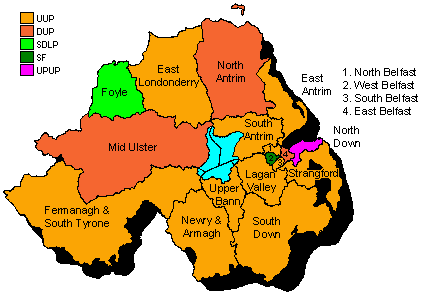 This was the first Westminster election to be fought across the whole of
Northern Ireland by Sinn Fein since 1959, when it had gained 10% of the
votes (to the Unionists' 77%). There was intense competition between SF
and the SDLP for the Nationalist vote, and equally intense competition
between the DUP and Ulster Unionists on the other side. In addition, Gerry
Fitt, who had resigned from the SDLP completely in 1979, was defending
his West Belfast seat as an Independent Socialist, and Jim Kilfedder was
opposed by Bob McCartney of the Ulster Unionists in North Down.
This was the first Westminster election to be fought across the whole of
Northern Ireland by Sinn Fein since 1959, when it had gained 10% of the
votes (to the Unionists' 77%). There was intense competition between SF
and the SDLP for the Nationalist vote, and equally intense competition
between the DUP and Ulster Unionists on the other side. In addition, Gerry
Fitt, who had resigned from the SDLP completely in 1979, was defending
his West Belfast seat as an Independent Socialist, and Jim Kilfedder was
opposed by Bob McCartney of the Ulster Unionists in North Down.
The DUP held North Antrim and East Belfast, lost North Belfast to the Ulster Unionists but gained Mid-Ulster by 78 votes ahead of SF, and were narrowly beaten by the Ulster Unionists in East Antrim. Splits on the Nationalist side allowed the Ulster Unionists to regain Fermanagh/South Tyrone, win Newry/Armagh and retain South Down. The Ulster Unionists also won the new seats of Strangford, Upper Bann, East Londonderry, and Lagan Valley where the party leader, Jim Molyneux, easily disposed of a DUP challenge. However Kilfedder retained his seat in North Down.
John Hume, who had succeeded Fitt as leader of the SDLP, won the new
Foyle seat. Fitt came third in West Belfast, behind both his former party's
Joe Hendron and Sinn Fein leader Gerry Adams. Adams won the seat but refused
to sit in Westminster.
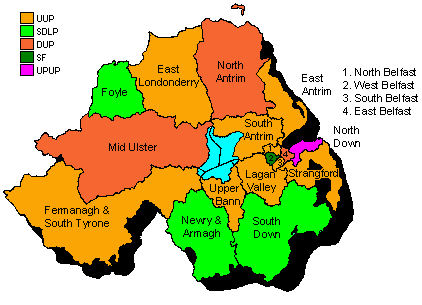 The Unionists maintained their electoral pact, at the cost of some internal
friction in the DUP and an open split in the Ulster Unionists in North
Down; their candidate Bob McCartney refused to stand down to give Kilfedder
a clear run, was expelled from the party and stood anyway as a Real Unionist.
The Alliance Party made some progress, with John Alderdice in East Belfast
getting the highest percentage vote ever for the party at a Westminster
election (he became party leader later in the year). The continuing shift
of Nationalist votes to the SDLP gained them South Down and ended Enoch
Powell's parliamentary career.
The Unionists maintained their electoral pact, at the cost of some internal
friction in the DUP and an open split in the Ulster Unionists in North
Down; their candidate Bob McCartney refused to stand down to give Kilfedder
a clear run, was expelled from the party and stood anyway as a Real Unionist.
The Alliance Party made some progress, with John Alderdice in East Belfast
getting the highest percentage vote ever for the party at a Westminster
election (he became party leader later in the year). The continuing shift
of Nationalist votes to the SDLP gained them South Down and ended Enoch
Powell's parliamentary career.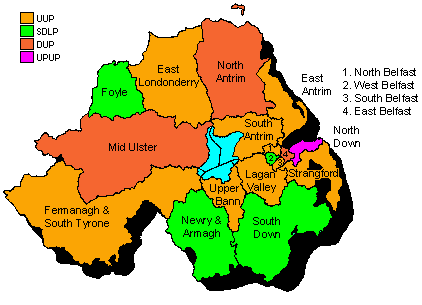 The newest party to appear on the scene, inspired by McCartney's 1987 campaign,
was the Northern Ireland Conservatives, who mounted a particularly strong
challenge in North Down. In the event they failed to unseat Jim Kilfedder
(who was knighted shortly afterwards) and their claims to represent the
mainstream of non-sectarian politics were dented by the fact the Alliance
beat them everywhere else. The main interest of the election turned out
to be West Belfast where the SDLP's Joe Hendron beat SF's Gerry Adams on
the third attempt, and retained his seat despite a subsequent court case.
The newest party to appear on the scene, inspired by McCartney's 1987 campaign,
was the Northern Ireland Conservatives, who mounted a particularly strong
challenge in North Down. In the event they failed to unseat Jim Kilfedder
(who was knighted shortly afterwards) and their claims to represent the
mainstream of non-sectarian politics were dented by the fact the Alliance
beat them everywhere else. The main interest of the election turned out
to be West Belfast where the SDLP's Joe Hendron beat SF's Gerry Adams on
the third attempt, and retained his seat despite a subsequent court case.
Three months later Jim Molyneux resigned as leader of the Ulster Unionists and was succeeded by David Trimble. He was subsequently knighted and received a life peerage when he stood down at the 1997 election.
West Tyrone was formed from the western part of Mid Ulster and the southern fringes of Foyle (which is now equivalent to the Derry City Council area). Mid Ulster took in compensation the southern part of East Londonderry and the northern fringe of Fermanagh/South Tyrone. Newry/Armagh and Upper Bann were barely changed. South Down lost its northern fringes to Strangford and Lagan Valley, which in turn lost ground to the outward expansion of the Belfast constituencies. North Down swapped some territory with Strangford. North Belfast expanded into East Antrim; South Antrim was barely changed and North Antrim not at all. Of the new eighteen seats six have Nationalist majorities (West Belfast, South Down, Foyle, Mid-Ulster, Newry/Armagh, and West Tyrone); Fermanagh and South Tyrone has had a series of closely balanced election results, and the other eleven have Unionist majorities, at least in elections to date.
The very idea of holding elections as a run-up to multi-party peace talks in 1996 was controversial and is believed by some to have contributed to the resumption of violence by the IRA in February of that year. Various options were considered, including: a list system election with Northern Ireland as a single constituency; an 'indexation' system, where the relationship between seats and votes would have been non-linear; pairing off the new constituencies to make nine electoral districts; and the old favourite of the single transferable vote in each parliamentary constituency. The system eventually chosen for the May 30 Forum/talks elections included elements of all of these. Each of the 18 new constituencies elected five representatives from closed party lists using the d'Hondt formula. In addition, each of the ten parties with the most votes across Northern Ireland elected another two representatives. This ensured that the PUP and UDP gained representation.
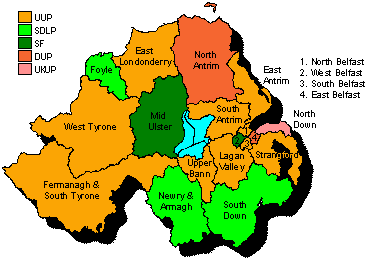 The new electoral landscape resulted in a few changes of personnel. Jim
Molyneux retired in Lagan Valley but a fellow Ulster Unionist kept the
seat. Less fortunate were the DUP in Mid-Ulster and SDLP in West Belfast,
both of whom lost to Sinn Fein's Martin McGuinness and Gerry Adams respectively.
A very tight contest in the new West Tyrone constituency resulted in victory
for the Ulster Unionist candidate.
The new electoral landscape resulted in a few changes of personnel. Jim
Molyneux retired in Lagan Valley but a fellow Ulster Unionist kept the
seat. Less fortunate were the DUP in Mid-Ulster and SDLP in West Belfast,
both of whom lost to Sinn Fein's Martin McGuinness and Gerry Adams respectively.
A very tight contest in the new West Tyrone constituency resulted in victory
for the Ulster Unionist candidate.As in 1996, the election system for the new Assembly to be set up under the Agreement was a controversial issue and came close to derailing the entire process in the early hours of Good Friday. Some of the smaller parties wanted some form of the 'top-up' system used in 1996 retained. In the end the political compromise was that all eighteen constituencies would elect not five but six members of the new body by Single Transferable Vote. This actually has resulted in some distortion. Jim Riley has pointed out (in a post to uk.politics.electoral on 9 November 1998) that it would have been more proportional for the four constituencies with the largest electorate (North Antrim, Lagan Valley, Newry/Armagh and South Down) to elect seven members of the Assembly, and for the four smallest (West Tyrone, East Antrim, East Londonderry and Mid Ulster) to elect five. However he further concluded that the results would have been much the same (SDLP losses in East Antrim and West Tyrone offset by gains in Newry/Armagh and South Down; SF loss in Mid-Ulster offset by gain in North Antrim; Ulster Unionist loss in East Londonderry offset by gain in Lagan Valley)
The death of the Ulster Unionist MP for South Antrim in April 2000 necessitated a by-election in September, which was won quite narrowly by the DUP.
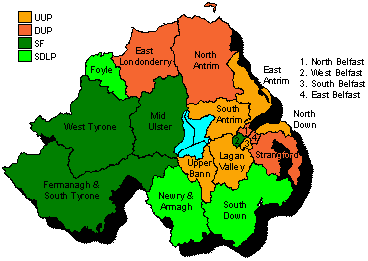 The impact of the Good
Friday Agreement was dramatically demonstrated in the biggest electoral
shift since 1974, with no less than seven seats changing hands. The UUP
claimed the scalp of Bob McCartney in North Down and regained their
by-election loss in South Antrim, but lost West Tyrone and
Fermanagh-South Tyrone to Sinn Fein, and Strangford, East Londonderry
and North Belfast to the DUP.
The impact of the Good
Friday Agreement was dramatically demonstrated in the biggest electoral
shift since 1974, with no less than seven seats changing hands. The UUP
claimed the scalp of Bob McCartney in North Down and regained their
by-election loss in South Antrim, but lost West Tyrone and
Fermanagh-South Tyrone to Sinn Fein, and Strangford, East Londonderry
and North Belfast to the DUP. 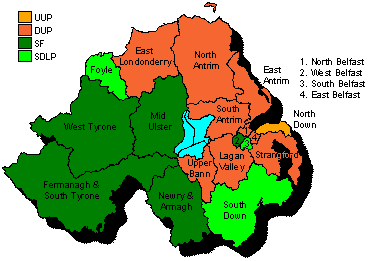 No less dramatic in terms of
results was the next election, which took place during a stalemate in
the peace process: the UUP lost all but one of their MPs, including
that of their leader, David Trimble, and the DUP won half of the 18
seats. In addition the SDLP were able to balance the anticipated loss
of Newry and Armagh to Sinn Fein with the unexpected gain of South
Belfast.
No less dramatic in terms of
results was the next election, which took place during a stalemate in
the peace process: the UUP lost all but one of their MPs, including
that of their leader, David Trimble, and the DUP won half of the 18
seats. In addition the SDLP were able to balance the anticipated loss
of Newry and Armagh to Sinn Fein with the unexpected gain of South
Belfast. The Jenkins Commission Report on reform of the electoral system in the UK recommended that the House of Commons should in future be elected by a system where most MPs are elected in single-seat constituencies, by the Alternative Vote (i.e. Single Transferable Vote for one seat), and about 15% are then elected from regional lists to produce a more proportional result. It seems currently (2003) very unlikely that this proposal will ever be implemented. I have analysed the Jenkins recommendations in the light of the 2001 election; at present this seems likely to remain a theoretical exercise.
In the meantime the Boundary Commission announced its review of the 18 constituencies in May 2003. I have speculated about the possible outcomes but the Provisional Recommendations were announced in April 2004.
See also: The Boundary Commission's Provisional Recommendations | Boundary Commission 2003
Westminster elections 1885-1910 | The 1918 election | Dáil elections since 1918 | Westminster elections since 1920 | Senate of Southern Ireland 1921 | Irish Senate elections in 1925 | Northern Ireland House of Commons | Northern Ireland Senate
Surveys of each recent election: 2004 European | 2003 Assembly | 2001 Westminster | 2001 local govt | 2000 S Antrim | 1999 European | 1998 Assembly | 1997 local govt | 1997 Westminster | 1996 Forum | 1995 N Down | 1994 European | 1993 local govt | 1992 Westminster | 1989 European | 1989 local govt | 1987 Westminster | 1986 by-elections | 1985 local govt | 1984 European | 1983 Westminster | 1982 Assembly | 1981 local govt | 1979 European | 1979 Westminster | 1977 local govt | 1975 Convention | Oct 1974 Westminster | Feb 1974 Westminster | 1973 Assembly | 1973 local govt | Summary of all Northern Ireland elections since 1973 | Brief summary of election results 1997-2003
Other sites based at ARK: ORB (Online Research Bank) | CAIN (Conflict Archive on the INternet) | Northern Ireland Life and Times Survey
Front page | Site Map | Notes and Queries | Updates Mailing List | About this site
Your comments, please! Send an email to me at nicholas.whyte@gmail.com..
Nicholas Whyte, 12 December 1998; modified 12 May 2004
|
Disclaimer:©
Nicholas Whyte 1998-2004 Last Updated on Wednesday, 12-Jan-2005 12:12
|